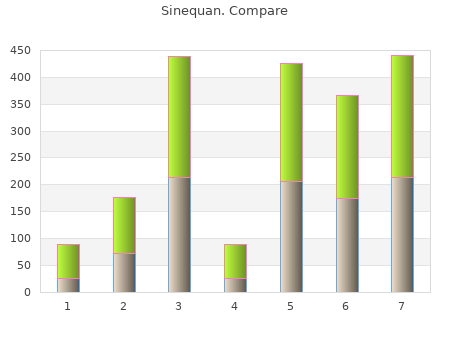By J. Dolok. University of Miami.
She continues to have significant pain and morning stiffness in her hands and wrist order 75 mg sinequan. She has been reading about the many available therapies for RA and feels that she now needs additional therapy buy sinequan 75mg amex. You explain that the NSAID was only the starting point for her medical ther- apy and that you agree that it is time to change her therapy. Which of the following statements regarding accepted medical therapy of RA is false? An acceptable escalation in this patient’s therapy would be to begin methotrexate at the recommended starting dose B. The antimalarial drug hydroxychloroquine is useful as early second- line therapy for RA C. An acceptable escalation in this patient’s therapy would be to replace her current therapy with infliximab monotherapy D. The conventional wisdom is that glucocorticoids neither alter the course of the disease nor affect the ultimate degree of damage to joints or other structures Key Concept/Objective: To understand medical therapy for RA 6 BOARD REVIEW Advancement from NSAIDs to second-line agents is recommended if (1) symptoms have not improved sufficiently after a short trial of NSAIDs, (2) the patient has aggressive seropositive disease, or (3) there is radiographic evidence of erosions or joint destruction. The trend today is for more aggressive treatment, and the majority of patients require addi- tional pharmacotherapy. Most patients require rapid advancement from NSAIDs to a sec- ond-line agent, most often methotrexate. In the United States, most rheumatologists prefer to increase the methotrexate dosage rapidly to 20 to 25 mg/wk and then add another agent within 2 to 3 months if necessary. The antimalarial drug hydroxychloroquine is useful as early second-line therapy for RA. Its response rate is lower than that of methotrexate, and less improvement is seen; however, its relative safety makes it an ideal choice for patients with mild early disease or as an additive agent in combination therapy. Infliximab is used in combination with methotrexate; this appears to permit long-term use of infliximab with less formation of neutralizing antibodies.

Thus generic sinequan 10 mg otc, a definition might be suggested for this lymph adipose system that may provide a key to understanding the etiology of a widespread unaesthetic pathology that potentially entails local and systemic degenerative processes such as lipolymphedema buy sinequan 25 mg mastercard. A closer view of the various clinical manifestations usually classified under the generic term ‘‘cellulite’’ provides—sometimes ready and often evasive—evidence of the specific clinical and symptomatological differences among lymphedema, lipedema, lympholipe- dema, lipomatosis, and lipodystrophy. Among hypertrophic forms, the most widespread are lipomatous lipodystrophies, Launois–Bensaude’s syndrome, insulin lipodystrophy, and Dercum’s disease (42). Dercum’s disease shows signs of sequential lipolymphedema with periods of neurop- sychological or metabolic disorders and alterations in the lower abdomen and adynamia. Pathogenesis includes neurovegetative, hypothalamic, and hypophyseal alterations, and might be caused by interstitial phlogosis produced by branches of the nervous system, i. A similar phenomenon might be assumed for lipolymphedema considering the inter- stitial phlogosis of nervous and fibrillary branches as the direct or indirect cause of the increase in local lipogenesis. It seems that German authors have identified an intestinal streptococcal microorganism as causing matrix alteration. In lipolymphedema, there are certainly clear correlations among alterations of the intestinal flora, metabolic acidifying alterations of the extracellular matrix, hyperinsuline- mia, and peripheral hyperestrogenism. Therefore, the adipocyte and the extracellular matrix condition would be affected at least at the initial phases (with regard to the lymphatic or venous system). Over the superficial fascia at the dermal level, an extremely diffuse lipolymphedema may be noticed, which improves with sun exposure and also when the patient stops wear- ing elastic hose. This type of ‘‘superficial cellulite’’ might be attributed to superficial vascular altera- tions due to unnecessary elastic compression, the low energy derived from low arterial flow, lipogenesis, and also cellular oxidation. Primary vascular alterations would be more evident at the surface than within the subcutaneous tissue, where the extracellular matrix and the lymphoadipose system would be mainly affected. At the dermal level, microcirculatory turbulences might provide basic conditions for the disease, which might later evolve into liposclerosis. Therefore, Vage’s observations regarding circulatory factors might be valid, because he says, ‘‘blood and lymphatic flows through adipose tissue are inversely proportional to its growth.
The stiffness of PPF/autograft at a low autograft mixing ratio (25/ 75) was measured and found to be slightly less than untreated defects buy sinequan 75 mg on-line. Biomechanical results were similar to the histomorphometric findings indicating that the bone–material composite mechanical properties were related to new bone formation cheap sinequan 10mg on line. CONCLUSIONS Several materials have been tested for the treatment of osseous periodontal defects. Materials have been evaluated based upon their ability to not only support bony recovery, but also periodon- tal regeneration. The ideal properties of a repair material for periodontal defects are biocompati- bility, osteoconductivity, osteoinductivity, availability, resorbability, ability to stabilize the de- fect site under mechanical stresses, and ease of application. Although several of these properties may be found in certain materials, it is difficult to find a material where all of these criteria are satisfied. A new material based upon the resorbable polymer poly(propylene glycol-co-fumaric acid) has been investigated for the treatment of periodontal defects. The PPF-based bone graft substitute supported new bone formation in a mandibular defect model. The material is osteocon- ductive, but may be mixed with a relatively small percentage of autograft to enhance its bone regenerative properties. Additional studies will be necessary to evaluate the PPF-based graft substitute’s ability to support periodontal regeneration. However, the results indicate that the PPF-based material may provide a new treatment method for oral, maxillofacial, and periodontal defects. Table 2 Stiffness of Test Material/Bone Complex at 7 Weeks Postoperative Test material Stiffness (N/mm) PPF 99 6 DMB 176 40 Autograft 126 39 PPF/autograft (75/25) 54 34 PPF/autograft (25/75) 102 24 Empty control 80 20 192 Hile et al. ACKNOWLEDGMENTS The authors would like to recognize the support provided by NIH/NIAMS Grant No. A clinical and histological evaluation of autogeneous iliac bone grafts in humans. Fracture at the iliac bone graft harvest site after fusion of the spine.

Little Brown buy sinequan 10mg low cost, Boston 64 Vestibular nerve Genetic testing NCV/EMG Laboratory Imaging Biopsy Posturometry + MRI Vestibulometry Quality Special sensory: balance information from the semicircular canals Anatomy The vestibular apparatus consists of the saccule sinequan 10mg mastercard, the utricle and the semicircular canals. The semicircular canals perceive angular movement of the head in space. The saccule and utricle perceive the position of the head with respect to gravity. Hairy cells within the apparatus synapse with peripheral processes of the primary sensory neurons, whose cell bodies constitute the vestibular ganglion. Central processes from the vestibular ganglion cells form the vestibular part of the VIII nerve. The nerve runs with the cochlear division and the VII nerve through the internal acoustic meatus and terminates in the vestibular nuclear complex at the floor of the fourth ventricle. A limited number of axons termi- nate in the flocculonodular lobe of the cerebellum. The secondary sensory neurons, whose cell bodies form the vestibular nuclei, send axons mainly to the cerbellum and lower motor neurons of brain stem and spinal cord (modulating muscle activation for keeping balance). In the lateral vestibular nucleus, axons project ipsilateral and caudal into the spinal cord and vestibulospinal tract (to lower motor neurons for the control of antigravity muscles). The medial and inferior vestibular nuclei have reciprocal connections with the cerebellum (vestibulocerebellar tract), which allows the cerebellum to coordinate balance during movement. All nuclei in the vestibular complex send fibers into the medial longitudinal fasciculus (MLF), which serves to maintain orientation in space. Connections between CN III, IV, and VI allow the eyes to fixate on an object while the head is moving. Vestibular axons in the descending part of the MLF are referred to as the medial vestibulospinal tract, and influence lower motor neurons in the cervical spinal cord bilaterally. Symptoms Patients experience dizziness, falling, vertigo, and nausea/vomiting. Signs Lesions result in abnormal eye movements, and problems with stance, gait, and equilibrium. Pathogenesis Metabolic: Diabetes, uremia 65 Toxic: Alcohol Aminoglycosides Cytostatic drugs: cisplatin, cyclophosphamide, hydroxurea, vinblastine Heavy metals Lead Mercury Quinine, salicylates Vascular: Anterior inferior cerebellar artery (AICA) Posterior communicating artery aneurysm Unruptured aneurysms, large vascular loops Vascular lesions of the spiral ganglion Vertebrobasilar circulation (history of hypertension, diabetes) Infection: Labyrinthitis: specific and unspecific: Suppuration reaches inner ear by either blood, or direct invasion (meningoencephalitis).

In this section effective 75mg sinequan, patello-femoral and tibia-femoral contact forces exerted during kicking types of activities are presented by means of a dynamic model of the knee joint which includes tibio-femoral and patello-femoral articulations and the major ligaments of the joint buy sinequan 75 mg without prescription. Major features of the model include two contact surfaces for each articulation, three muscle groups (quadriceps femoris, ham- strings, and gastrocnemius), and the primary ligaments (anterior cruciate, posterior cruciate, medial collateral, lateral collateral, and patellar ligaments). For a quantitative description of the model, as well as its mathematical formulation, three coordinate systems as shown in Fig. An inertial coordinate system (x, y) is attached to the fixed femur with the x axis directed along the anterior-posterior direction and the y axis coinciding with the femoral longitudinal axis. The moving coordinate system (u, v) is attached to the center of mass of the tibia in a similar fashion. The second moving coordinate system (p, q) is connected to the attachment of the quadriceps tendon, with its p axis directed toward the patella’s apex. Since we are dealing here with an anatomically based model of the knee joint, the femoral and tibial articulating surfaces as well as posterior aspect of the patella and intercondylar groove must be represented realistically. This is achieved by utilizing previously obtained polynomial functions. Equations of motion of the tibia can be written in terms of these three variables, along with the mass of the lower leg (m), its centroidal moment of inertia (I), the patellar ligament force (FP), the tibio-femoral contact force (N2), the hamstrings and gastrocnemius muscle forces (FH, FG), the weight of the lower leg (W), and any externally applied force on the lower leg (FE). The contact conditions at the tibio-femoral articulation and at the patello-femoral articulation are expressed as geometric compatibility and colinearity of the normals of the contact surfaces. The force coupling between the tibia and patella is accomplished by the patella ligament force FP. The model has three nonlinear differential equations of motion and eight nonlinear algebraic equations of constraint. The major task in the solution algorithm involves solution of the three nonlinear differential equations of the tibia motion along with three coupled nonlinear algebraic equations of constraint associated with the tibio-femoral articulation. This is accomplished by following solution techniques developed by the author and his colleague which are also described in Section 3. The kicking type of lower limb activity is a rather complex activity that involves most of the muscles of the lower limb.





